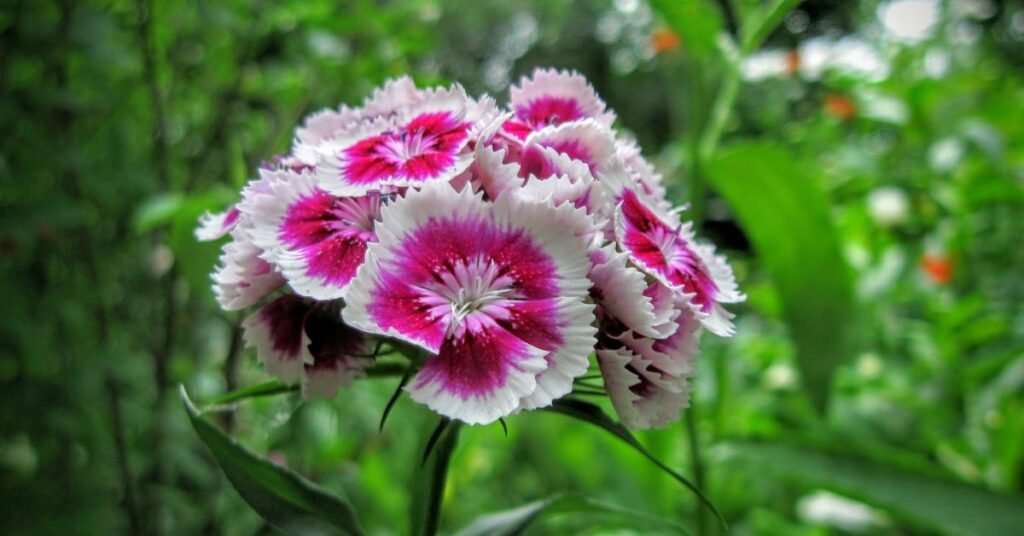Introduction
The Dianthus plant, often called Pinks or Carnations, is one of the most charming flowering plants known for its colorful, fragrant blooms and evergreen foliage. This plant adds a burst of life and beauty to any garden, balcony, or landscape. Native to Europe and Asia, Dianthus belongs to the Caryophyllaceae family and includes over 300 species, such as Dianthus barbatus (Sweet William) and Dianthus caryophyllus (Carnation).
Whether you’re a beginner or an experienced gardener, Dianthus is a must-have plant due to its easy-growing nature and long-lasting flowers.
Appearance and Characteristics
Dianthus plants produce small, ruffled, and often fragrant flowers in various shades, including pink, red, white, purple, and bi-colored varieties. The petals usually have a fringed or serrated edge, giving them a delicate and romantic appearance.
The foliage is grayish-green and narrow, which complements the bright flowers beautifully. Most varieties bloom from late spring through early fall, especially when grown under the right conditions.
Common Varieties of Dianthus:
- Dianthus barbatus — Sweet William
- Dianthus chinensis — Chinese Pink
- Dianthus caryophyllus — Carnation
- Dianthus deltoides — Maiden Pink
Each variety offers a unique flower shape and growth pattern, but all share the same elegant charm and fragrance.
Ideal Growing Conditions
1. Light Requirements
Dianthus thrives best in full sun, needing at least 6 hours of direct sunlight daily. In partial shade, flowering may reduce, and plants might grow leggy. A sunny spot ensures compact growth and vibrant blooms.
2. Soil Type
These plants prefer well-drained, slightly alkaline soil with a pH between 6.0 and 7.5. Sandy or loamy soil works best, as Dianthus roots can rot in soggy or clay-heavy soil. Adding organic compost or perlite improves soil aeration and drainage.
3. Watering
Dianthus likes moderate watering. Keep the soil moist but not waterlogged. Water the plant deeply once or twice a week, allowing the top layer of soil to dry out between waterings. Overwatering can lead to fungal diseases like root rot.
4. Temperature and Humidity
Dianthus prefers cool to moderate temperatures between 15°C and 25°C. High humidity may cause mildew or fungal issues, so ensure good air circulation around the plant.
How to Plant Dianthus

Planting from Seeds
- Sow Dianthus seeds indoors 6–8 weeks before the last frost.
- Use seed trays filled with light potting mix.
- Gently press seeds into the soil (don’t bury them deeply).
- Keep them moist until germination, which usually takes 7–10 days.
- Once seedlings are strong enough, transplant them into the garden after frost danger has passed.
Planting from Cuttings
For faster results, you can also propagate Dianthus through cuttings:
- Cut 4–6 inch stem tips from healthy plants in early summer.
- Remove lower leaves and dip the cut end in rooting hormone.
- Plant in moist, well-draining soil or potting mix.
- Keep in indirect light until roots develop (about 3–4 weeks).
Caring for Dianthus Plants
1. Pruning and Deadheading
Regularly remove faded or spent flowers to encourage new blooms. Pruning keeps the plant compact and prevents it from becoming woody. Cut back stems after the flowering season to promote new growth for the next year.
2. Fertilizing
Feed your Dianthus once every 4–6 weeks with a balanced, slow-release fertilizer during the growing season. Avoid over-fertilizing, as this can cause more foliage growth and fewer flowers.
3. Mulching
Apply a thin layer of mulch around the plant base to retain moisture and prevent weeds, but keep it away from the stems to avoid rot.
4. Pest and Disease Control
Common pests include aphids, slugs, and spider mites. Use neem oil or insecticidal soap for control. Fungal diseases like powdery mildew or root rot can occur if the soil is too moist, so ensure proper drainage and spacing between plants.
Blooming Season and Longevity
Dianthus generally blooms from late spring to early autumn. If well-maintained, it produces continuous flowers with delightful fragrance. Perennial varieties come back each year, while annual types complete their life cycle within one season.
After blooming, cut back the plants to about half their height. This helps rejuvenate them for a second flush of blooms later in the season.
Using Dianthus in Garden Design
Dianthus fits perfectly in various garden styles and settings:
- Borders and Edging: Compact varieties make excellent borders along walkways or flowerbeds.
- Rock Gardens: Their hardy nature and low growth make them ideal for rock or alpine gardens.
- Container Gardens: Grow them in pots, hanging baskets, or window boxes for vibrant displays.
- Cut Flowers: Carnation-type Dianthus varieties are popular in floral arrangements due to their long-lasting blooms and pleasant scent.
Winter Care
In colder climates, protect Dianthus from frost by covering the base with mulch or straw. Perennial types may survive light frost, but extreme cold can damage roots. For potted plants, move them indoors to a cool, bright area until spring.
Benefits of Growing Dianthus
- Fragrance: Fills your garden with a sweet, clove-like scent.
- Pollinator-Friendly: Attracts bees and butterflies.
- Low Maintenance: Easy to grow and manage.
- Versatile: Suitable for borders, containers, and floral decorations.
- Evergreen Foliage: Keeps your garden green even in off-seasons.
Conclusion
The Dianthus plant is an excellent choice for gardeners who love colorful, fragrant, and low-maintenance flowers. Its long blooming season, versatility, and beauty make it perfect for enhancing gardens, balconies, or landscapes. With proper sunlight, well-drained soil, and regular pruning, Dianthus will reward you with stunning flowers year after year.

